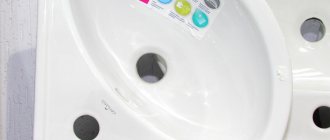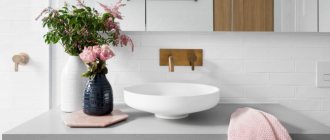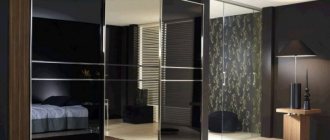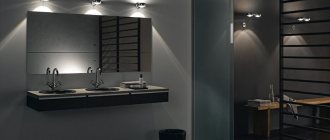A sink in a bathroom is an essential attribute. It is almost impossible to imagine this room without a washbasin.
Let's figure out what you should pay attention to when choosing this piece of plumbing and consider popular options.
Table top model
A countertop sink in a bathroom will be needed if it is equipped with a countertop or cabinet. If you follow all the rules for installing such plumbing fixtures, the wooden surface of the furniture that serves as a support will not constantly get wet and then dry out and delaminate.
A bathroom sink built into a countertop has a number of undeniable advantages:
- it can even be adjacent to a plywood partition, since it does not require wall mounting;
- the furniture set supporting it easily hides pipes, siphons, hoses and other aesthetically unfavorable elements;
- in the support cabinet you can store shampoos, soap, a broom, paste for cleaning plumbing fixtures and tiles.
Sink sizes: technical and aesthetic aspects
A very important characteristic of a washbasin of any shape and type of installation is its dimensions. This indicator has both technical and aesthetic sides. If a large sink is installed in a small room, it not only takes up a lot of space, but also spoils the interior with its bulkiness. And vice versa, the original miniature model will be “lost” in the free space of a large room.
Choosing washbasin sizes that are proportional to the dimensions of the room is an important condition for creating an interesting interior and providing a feeling of comfort. The ergonomics of the area as a whole depends largely on the size. The need to reach, bend significantly, and constantly monitor the position of your hands complicates the washing procedure, strains your psyche and reduces your positive emotional mood.
Unfortunately, the ever-increasing trend towards improving the design of sinks has, to a certain extent, led to the fact that some manufacturers have moved away from dimensional standards in the manufacture of products. And this cannot but affect the ease of use. This was especially reflected in exclusive models.
Important! When choosing a sink of an original shape, you should definitely analyze and evaluate the process of its use. Multi-level edges can add originality to the product, but it is almost impossible to use such a sink without significant splashing of water beyond its boundaries.
Based on the size of the bathroom sink, it can be divided into the following types:
- full-size products;
- mini-sinks, compact;
- expanded (usually due to additional horizontal surfaces);
- exclusive options.
When choosing a sink of an original shape, it is necessary to evaluate and analyze the process of its use
Before purchasing a washbasin, you must take measurements of the part of the room where you plan to install it.
Bathroom sink height: standard and possible variations
One of the dimensional indicators of a sink is height. The distance from the floor to the top point of the outer edge is taken into account (for some models, part of the sink in the area where the mixer is installed may be raised). The optimal dimensions of a bathroom sink, in particular the height, are determined in the corresponding document. According to SNiP 3.05.01-85 it should be 80-85 cm, deviations are allowed by 2 cm.
Modern manufacturers easily flout established (in fairness, it should be noted that a very long time ago) standards, based on third-party opinions and their own research, and increase the height of products to 92 cm, and sometimes more.
Hanging and mortise models that do not have cabinets can be installed at the desired height, taking into account the physical features and preferences of the users. Usually the height of all adult users is summed up and the average is displayed. You can buy steps for children; there are quite a few of them available in plumbing stores.
It’s more difficult with floor models and countertops with cabinets. These bathroom sinks have fixed dimensions and most often cannot be adjusted. Theoretically, it is possible to reduce the leg, but this will not be done without the use of special equipment and loss of aesthetics - you can only shorten the lower part, which means that the proportions will be disrupted and the design idea will be distorted. Some cabinets with table tops have adjustable legs that allow you to increase the height of the structure by a maximum of 4 cm.
Therefore, when choosing a sink with a fixed height, you must first determine the required size.
According to SNiP 3.05.01-85, sinks from the floor should be placed at a height of 80-85 cm
Optimal sink depth for a bathroom
As for the depth of the sink, it is determined by the distance from the top edge of the bowl to the bottom inner point, that is, the drain. There is no specific standard for this value. Many are guided by taste preferences, choosing a shallow or deep bowl. For example, it is better to purchase a built-in sink for the bathroom, which has a significant indicator - at least 18 cm. Otherwise, the external effect of such an arrangement of the washbasin is lost.
If the depth is less than 15 cm, it is unlikely that you will be able to wash your hands under a strong stream of water without splashing outside the sink. When using a swivel spout, splashing may also occur when the flow is not directed towards the drainage area.
When marking products, some manufacturers indicate not the depth, but the distance from the uppermost point to the lowest outer point of the bowl. This value is important when connecting communication taps.
For overhead sinks in the bathroom, in addition to performance qualities, depth is also important as an interior component. Such designs are often accentuated, so correctly selected sizes will enhance or reduce the aesthetic significance of the sink for the overall perception of the design.
Helpful advice! If you need to make a choice between several products, it is worth considering that a deep bowl is much more convenient to use.
Length and width of bathroom sinks and performance
Before trying to understand the length and width of sinks, it is worth distinguishing between the indicators of the bowl itself and the product as a whole (taking into account the sides and other horizontal surfaces that make up the structure).
For comfortable use of the sink, its internal central zone should be at least 50x35 cm
These parameters are the same for integrated built-in bathroom sinks. Most often, they are almost identical for overhead structures of round and oval shape. For other models, the differences can be significant.
The length should be taken as the distance between the lateral extreme points; the width is determined by the segment connecting the central points on the front and rear edges of the shell.
Which sink is more convenient - wide or long? There is no clear answer to this question. These parameters are often selected in accordance with the design. For comfortable use, an internal central zone of at least 50x35 cm is required. There are sinks of much smaller dimensions, but their use is somewhat complicated precisely because of their size.
A built-in sink with rims may look quite large, but its functionality should be judged by the length and width of the bowl itself.
It is quite difficult to determine the performance characteristics of corner sink models, depending on the length and width. That is why such products must be evaluated based on the totality of all properties.
Efficient use of space: sink with side drain
Sometimes the conditions in the bathroom are such that it is almost impossible to take into account tips and recommendations for choosing and comfortable use of sinks. There is only one option - installation on an automatic washing machine. Everything is not easy, since you need to purchase both a special machine and a sink. Built-in and hanging options are not suitable - an overhead one is required, but of a special design.
The depth of the sink with side drain does not exceed 15 cm
First of all, you should choose an automatic machine of the appropriate size. It is required that the height does not exceed 70 cm, and the depth should be 15 cm less than the width of the sink. The last condition is mandatory for organizing the drain. The length must be the same; this will allow you to mount an aesthetic structure that appears monolithic in appearance.
Now about the sink. Most often these are flat models, the depth of which does not exceed 15 cm. In addition to the size, a necessary condition is the presence of a side drain. It is this feature that allows you to place a specific sink above the machine.
There are two more nuances, they are as follows: if the front part is mounted at the same vertical level, the design will be more attractive, but it will not be possible to get close to the sink; when installing a sink in a bathroom with an overhang of even 5–7 cm over the machine, standing will be much more comfortable, but it will become cumbersome. Which problem is the lesser evil is a subjective opinion.
Helpful advice! When purchasing a sink with a side drain, you need to pay attention to the presence of a slope. Its absence will contribute to the accumulation of water and the formation of plaque.
The presence of a side drain allows you to place the sink above the machine with virtually no gap
The probability of the appearance of “eternal” puddles
A countertop sink in a bathroom also has a number of disadvantages. This is, first of all, a considerable cost. It is due to the need to purchase appropriate furniture. The legs on which she rests will make it difficult to wipe the floor after washing or bathing.
To prevent such inconveniences, you can buy a wall-hung set with an overhead washbasin. However, this modification is applicable only on strong walls that can support a cabinet hanging on them.
How to choose the right mini-sink?
When planning to purchase a miniature sink, you will need to take into account a number of features that influence the choice of the optimal model.
Criterion #1 - sink dimensions
First of all, you should start from the size of the sink. If the bathroom area allows, it is better to choose the deepest model from the compact line.
It will not take up extra space, but will make it possible to carry out full sanitary and hygienic procedures with comfort.
Flat, shallow sinks are not the best option for a home bathroom. Splashes of water always fly out of them, settling in unaesthetic streaks and drops on the floor, walls, mirrors and household appliances
Criterion #2 - type of fastening
Equally important is the fastening of the plumbing element. Wall-mounted mini-sinks or water lily sinks look impressive, modern and stylish.
Under them you can place a small cabinet, a laundry basket, a washing machine or a stand with shelves for storing bath accessories. But the weight of the products is very large, and installation is only possible on strong load-bearing walls.
Installing a wall-hung sink requires strong dowels. If the model weighs a lot, it is recommended to use durable metal brackets. This will ensure that the plumbing fixtures are securely positioned on the wall and will minimize the possibility of the sink falling onto the floor or household appliances.
For owners living in old houses, it makes sense to pay attention to the classic type of plumbing equipment - a compact tulip sink.
In this version, the bowl is located on a special stable pedestal, behind which all communication connections are hidden.
Floor-standing sinks are presented on the market in the widest range and rich colors. You can choose the right product for any, even very complex interior design.
The fastening of washbasins with a pedestal is carried out using two studs and is not difficult at all. Not only an experienced installer, but also a home craftsman can handle the task.
Criterion #3 - material of manufacture
The material from which the sink is made also matters. If your budget is limited, you will have to choose a suitable model from the line of earthenware products. Such products combine optimal cost, good quality and a variety of shapes.
A mini-sink made of sanitary ware does not require labor-intensive maintenance. To ensure that the washbasin always looks neat, it is enough to wash it with a delicate detergent during cleaning, rinse it and wipe it with a dry microfiber cloth.
A model made of natural stone will cost much more, but will last longer and retain its spectacular original appearance.
The only disadvantage of washbasins of this type is their heavy weight. In tulips, overhead or built-in models this is not important, but for wall-mounted products it is extremely important.
Even the smallest wall-mounted stone module can only be mounted on strong walls and stable supporting structures. Otherwise, there is a high risk of it collapsing on the floor.
A glass sink will look catchy, stylish and original, but will require constant care. Otherwise, unsightly marks from water drops will settle on the surface and the model will lose its aesthetics and attractiveness.
Despite their high cost, miniature glass sinks are weak in strength. They must be used carefully, carefully protecting the fragile material from shock and other mechanical damage.
A metal product will be cheaper, but will not suit every interior. To make the model look organic, you will have to decorate the sanitary and hygienic premises in a more modern style, and this will require additional material costs.
Do not use abrasive cleaners to care for metal sinks. They will ruin the smooth, shiny surface and make it dull and worn out.
Criterion #4 - shape and type of product
The next selection criterion is the shape of the product. To arrange a bath room, it is worth considering oval or round models. They do not have sharp corners that you can hit if you are in a small bathroom with an irregular layout.
It is advisable to install faucets with a low spout on mini-sinks. If this point is ignored, splashes of water will scatter throughout the room, creating unsightly stains on surrounding objects.
If you want to use the bath area as efficiently as possible, you can purchase a mini-sink that can be built into the countertop.
They are conveniently integrated into the surface of wall-mounted or floor-standing cabinets and blend seamlessly with the interior.
All communication elements will be “hidden” under the pieces of furniture and the bathroom will look stylish, neat and attractive.
In cabinets with overhead sinks, you can successfully hide unaesthetic fragments of communications and store a large number of necessary bath and hygiene accessories
In this way, in one small area it will be possible to place both a convenient washstand and a spacious cabinet with shelves or drawers.
Miniature models for embedding on the plumbing market are presented in different configurations and original colors. The lower cabinet can be placed on the floor or attached to the wall, provided that the installation is carried out on a strong and reliable supporting structure
An equally good option is the triangular shape of the product. It can be conveniently positioned even in the tiniest sanitary area without disturbing users.
A compact small corner sink for a small bathroom will be the ideal solution. It will take up minimal space and will not interfere with full use of the room.
Corner sinks are widely available on the market. Finding the most attractive option will not be difficult even for demanding clients who meticulously plan every element of their home interior.
To create a cozy, calm atmosphere in a sanitary and hygienic room, you should use overhead bowls. They are not built into the countertop, but are mounted on top, giving the surroundings an elegant retro style.
There are no restrictions on color solutions. The owners can choose a model that matches the tone of the existing decorative design.
Mounting on brackets
The wall-mounted bathroom sink is fixed on metal holders firmly screwed into the wall. Most often they are sold complete with a sink.
In many cases, you can use the brackets on which the old sink was hung, if its length and width are approximately the same as the new one.
Installation of a wall-hung sink is only permitted on a load-bearing wall or a very strong dividing wall. If it is not possible to screw the brackets to a solid wall, this option will have to be abandoned.
Sink design
When designing models, manufacturers use all kinds of design solutions. This is important for buyers, since they need to choose a model whose appearance will fit well into the space and look appropriate.
Stylistic decisions may be different. You can find the best options for a classic interior. As a rule, these are sinks made in a restrained design and having regular shapes.
For modern trends, sinks are often purchased that attract attention with their original shapes, unusual design solutions and colorfulness.
You also have to choose the right color. Traditionally the shell is white. This is a very versatile color. But you can find a considerable number of other colors. They will look no less attractive if their use in the interior is justified.
Iron brackets will corrode
The undoubted advantages of this choice are
- easy and almost instant installation;
- complete freedom of action under the sink if necessary, clean the siphon and hoses;
- under the drainage system there will be space for a small storage chamber for washing and shaving supplies, as well as household chemicals.
The obvious disadvantages of this choice include the need to come to terms with the fact that hydraulic engineering will be exposed to public display. True, if desired, it can be placed in the wall if you first make an engineering niche there. The downside is that the paint from the brackets will crumble, and they themselves will become covered with rust over time.
What types of sinks are there - the optimal dimensions, time-tested
When answering the question of which sink is best for a bathroom, you need to choose the right size. It is important to consider the following parameters:
- Width. In this case, the area of the room plays a key role. However, 55-65 cm is considered the best option. Such washbasins are convenient and fit organically into any room.
- Height. The classic solution is considered to be a height of 13.5-15 cm. A deep bowl is considered more comfortable.
- Depth. This term refers to the dimension from the end of the sink to the wall. If there are small children in the house, it is better to give preference to the minimum sizes. If the distance is large, it will be difficult for them to reach the faucet. Regular sinks have a range of 44-61 cm.
The best choice for tight spaces
A sink with a cabinet in the bathroom is very popular today, since its design solution allows you to organize the space very rationally. This property is especially valuable in cramped standard apartments, where after installing a washing machine there is only a very narrow area for washing.
In a hardware department store you can always find plumbing fixtures with a cabinet that completely suit your size, style and shape. Those who have saved up a lot of money for renovations can also order a designer version of the cabinet, which fits perfectly with the existing interior.
The most important advantage of this design is the numerous pull-out shelves, which can easily accommodate hygiene products, washing powders, pumice stones, and washcloths.
Of great importance is the fact that the water supply communications, as well as the siphon and water supply holes in the walls will be completely hidden from view.
Which size should I choose?
The solution to the problem lies on the surface. For a small bathroom, a small sink will do. It will be comfortable to use such a washbasin, because it will not take up much space.
For a large area, a small sink will be inappropriate. It will not fit either in style or in size.
It is worth installing the washbasin in accordance with the space of the room. Some designs suggest installing a double sink. However, it is worth remembering that the distance between them should be at least a meter.
Recommendations when choosing sinks:
- Stick to one style for all plumbing fixtures;
- Choose models with a hole to prevent water overflow;
- Please note that the number of holes in the washbasin depends on the installation of the faucet;
- Inspect the item for chips, cracks and other damage;
- Measure the dimensions in advance;
Extreme ease of installation
A 60 cm sink with a bathroom cabinet is good not only for its compactness. Due to the fact that the upper section of the furniture completely follows the contours of the lower surface of the sink, there will be absolutely no problems when installing such a structure.
However, you will have to come to terms with the fact that a considerable part of the cabinet will be occupied by a bowl recessed into it, which will significantly reduce the space for storing bathrobes, towels, bottles of shampoo, shaving foam and bars of soap.
The disadvantages of this choice include the fact that the wood material used to make the cabinet will begin to swell in a few years from the effects of dampness, steam and caustic detergents, even under a durable layer of protective decor.
To avoid this phenomenon, the locker will have to be updated every two years. This will preserve the aesthetic value of the structure and will regularly introduce pleasant variety into the decor of a typical apartment.
DIY sink cabinets. Ideas.
When various bathroom storage ideas begin to come to mind, you need to implement them immediately. Well, if you can’t think of anything, here are some clues. For example, it couldn’t be simpler: a drawer with a couple of baskets on it in which you can store dirty laundry.
Wooden pallets are in vogue these days. They can be used to make anything for a specific interior. This is an option for the kitchen, but why not adapt it a little for shower storage if that's your style?
Such racks are not difficult to make, but they will look very homely. All you need are slats and boards)
- Types of shelving for bathrooms
- Bathroom design 2022 - 160 photos of the best new products
Bathroom interior 2022: fashion trends of this year, choice of decor and design (80+ photos)
Two wide boards...I think that's all?)
A minimum of minimalism) For proud singles who have time to make such a simple nightstand under the sink to store one towel and one toothbrush.
An option for making your own small space for storing household chemicals and other products for removing rust from clothes, for example.
If you have the skills of a carpenter (or you have such an object at home), then the option is more difficult for you. But he also looks much more presentable. Don't you think so?
The widest scope for creativity
It's no secret that sometimes owners of cramped apartments have to resort to the most incredible tricks when equipping their bathrooms. As a result, they manage to squeeze in a washing machine and a bathtub, but there is practically no space left for other plumbing fixtures. The best solution to this problem would be a corner sink in the bathroom.
Such models are offered in left and right versions, which allows you to solve any engineering problem. With all this, for any of the selected options, you can choose the most convenient fastening system. In fact, the only difference from installing a conventional sink will be the need to make allowances for the angular placement of the bowl.
Standard sizes of miniature washbasins
The class of small sinks includes products with the following parameters:
- length – from 20 to 45 cm;
- width – from 18 to 55 cm;
- depth – no more than 25 cm.
They are installed in small-sized bathhouses and combined sanitary facilities.
Compact washbasins perform the same functions as standard washbasins, but are considered somewhat less convenient.
A small washbasin with an original shape refreshes the interior and gives the bathroom a modern appeal and a special, unusual style.
However, to rationally use the usable space of a small room, some comfort options have to be sacrificed.
The floor and mirror will be splattered
The narrow configuration of such plumbing does not allow more than one hole for the mixer to be made in it. However, this does not remove the compact corner design from the general range of sinks, since options with two mixers have long gone out of use and today are considered no longer fashionable. The only real inconvenience in this case can be the need to confine yourself to a narrow area of the bowl while washing.
If you do not have the appropriate skills, you will have to wipe the floor after each hand washing or brushing your teeth. However, it is precisely this responsibility that will eventually wean you from waving your arms while taking water procedures.
As for the mirror for the corner sink, it can be as narrow as you like, since even for a “dangerous” shave, a reflection with an area of three to four square centimeters is enough.
Corner Bathroom Sinks – Shape
The shape of the corner sink is selected depending on the design of the rest of the plumbing.
The design of the desired interior is also of great importance:
- Round bowls harmonize in classic interiors, next to round bathtubs or semicircular sliding shower cabins.
- Straight bowls are suitable for modern interiors where square-rectangular baths or corresponding shower cabins are located.
Therefore, it is better to select themed products together with a bath, shower and toilet.
To ensure that the choice of several products is advantageous by default, individual manufacturers present plumbing fixtures in entire collections.
The main criterion is affordability
No matter how cramped and uncomfortable the apartment may be, today there are at least a hundred ways to turn its bathroom into a very comfortable and functional space.
It is enough to quickly study the photos of bathroom sinks published on the World Wide Web. There you will find suitable options for “secret houses”, and for trailers, and for modular Finnish houses.
The only objective limitation when choosing an apartment plumbing installation is its cost. However, this does not mean that you have to save money for an expensive sink for a long time, refusing to buy a cheap one. Most often, affordability is the criterion for the compatibility of a particular modification with the surrounding interior.
That is why it is better to buy exactly the sink model, the cost of which does not give rise to any doubts. This will not only save a lot of money, but also prevent the introduction of excessive visual dominance and stylistic disharmony into the interior.
Materials
An important selection criterion is the materials from which the sink is made.
This allows us to highlight several common options:
- Ceramic. Today, such models are among the most common. Indeed, you can see them on sale very often. They are offered by a considerable number of brands. The models presented in the catalogs look very attractive with good characteristics.
- Made from stainless steel. They look very stylish. The advantages also include good strength properties. You will be pleased with the reliability. The service life will be very long, making the purchase successful.
- Glass. The sinks look very impressive. In the interior they will not go unnoticed, because they look especially elegant.
- Wooden. They look incredibly interesting and stylish. The demand for them is not so high, which is explained by their higher cost compared to many other types.
- Stone. A significant advantage is good wear resistance. The appearance is especially luxurious due to the beauty of the material used. The disadvantages include the rather high cost offered for sale for models made using stone.
- Made of artificial stone - despite their magnificent appearance, such sinks are much cheaper, which makes them very popular on sale. They fit perfectly into the interior, decorating it.
The materials used for sinks have their own advantages and disadvantages and a certain cost. All these points, as well as many others, should be taken into account when choosing the appropriate look. Each type of sink has its own rules of care.
Photo of a bathroom sink
Bathroom lighting
When choosing lamps, pay attention to the protection class: they must be designed for use in wet rooms. This means that the protection class must be at least IP44. Only in this case will the bathroom lighting work for a long time and without problems.
When developing a luminaire layout, several lighting zones are most often made: a general ceiling lighting and several zones connected to separate switches. Several lamps near the mirror are a must, but you can also add lighting to the bathroom or shower.
There is a very interesting design move - to make built-in shelves and highlight them. Since the walls are often tiled, the effect is unexpectedly interesting. Lighting from below a bathtub or sink looks good. They are partially covered with a screen, and backlighting is installed behind it, possibly colored (from LEDs or LED strips).
The shape of the niches and the light are played up, a beautiful bathroom design consists of such little things. Illuminated shelves built into the wall. An interesting idea: niches illuminated by lamps. Beams of light in the right places - and the design of the bathroom becomes unusual. When using LED strips for bathroom lighting, the design becomes more expressive.
This lighting option Hiding the lamps behind the mirror achieves an interesting effect Lighting the mirror is one of the main points Narrow beams of light on the tiles look especially bright Large ceiling lamps are necessary when using dark colors in the design: a brown bathroom needs a lot of light Types of ceiling lamps for the bathroom. They all give a different stream of light - narrow or wide. Illumination of a corner bath using LED lamps
The lighting design of a bathroom is one of the key design points: well-chosen lamps unite everything into a single whole. One way is to install lamps with a narrow stream of light; they create glare on the tiles, which is reflected in the mirror and earthenware.
Choosing the right faucet
There are many mixers. According to the installation method they are divided into:
- mortise _ Attached to plumbing fixtures. They differ from each other in the length of the gander (spout), shape and design;
- wall- mounted Mounted into walls without connection to other elements;
- built- in Installed in walls. Only spouts and regulators lead outside.
According to the control method, they are distinguished:
- valve systems (traditional version);
- lever models (equipped with a handle);
- sensory (react to movements);
- portioned (water is supplied by pressing a button);
- combined (with a spout for discharging filtered water).
The length of the spout deserves attention. Long ones (25 cm or more) are suitable for deep built-in plumbing fixtures; short ones (no more than 15 cm) are suitable for designer sinks and models with a flat bowl. It is important that the length matches the dimensions of the plumbing fixtures. The best option is the distance of the spout from the edge is 5-7 cm.
The shape and materials should be chosen based on the overall design of the bathroom.
Shape and color
The shape of the shell is:
- square;
- round;
- rectangular;
- oval;
- triangular (for corner placement).
The choice depends on the size of the room and the style of the interior. In a small bathroom, a compact round countertop sink looks great placed on the countertop. Square and rectangular are organic as built-in cabinets.
Traditionally, plumbing fixtures are white. There are also different shades - from snow-white with a soft blue tint to milky. But modern manufacturers take into account different tastes and produce unique, creative models with different color schemes. When choosing an original sink with an unusual color design, remember that it should be in harmony with the walls, other furniture, plumbing fixtures and fit perfectly into the overall style.











